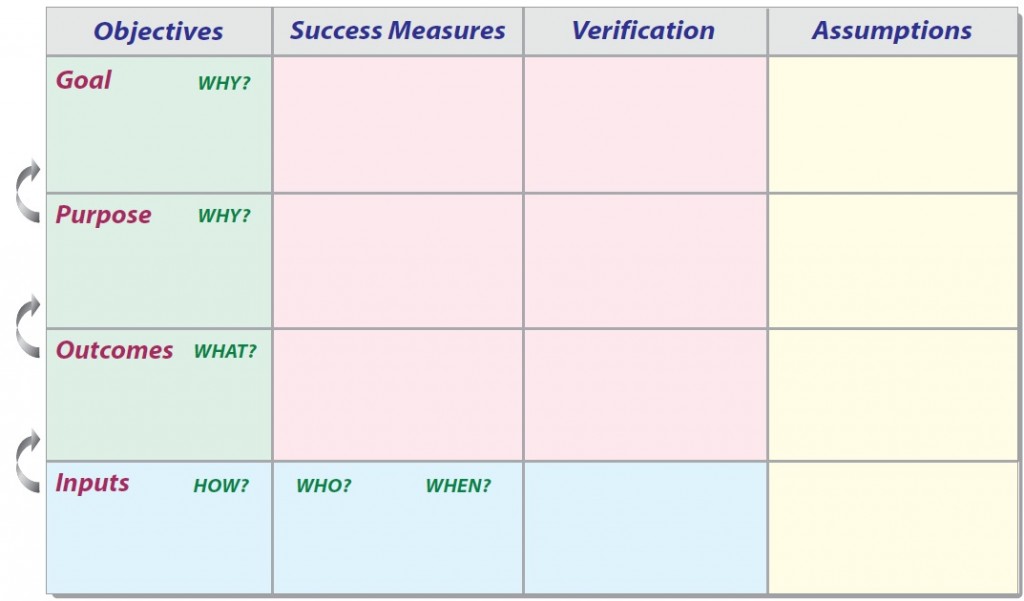You don’t need to be a rocket scientist to appreciate NASA Rule #15!
“A review of most failed projects and project problems indicates that the disasters were well-planned to happen from the start. The seeds of problems are laid down early. Initial planning is the most vital part of any project.” – NASA Rule #15
Sound familiar? How many times have your promising ideas stumbled when they could have sprinted with better initial planning?
You can’t skip the up-front strategic thinking and collaboration and jump directly to execution. That’s like building a house without first pouring the foundation. But even smart people fall into the “activity trap” by prematurely fleshing out to implementation tasks and schedule before adequately understanding the project as an integrated system.
Doing the vital initial planning right requires the right process and the right tools. We have them.
Discover the Logical Framework Approach
What distinguishes the results we get from that of other strategy consultants is that we feature a proven, powerful, and practical methodology: the Logical Framework Approach (LFA).
The Logical Framework Approach is arguably the most effective initial planning system because it lets you systematically build a strong foundation for predictable multiple success while eliminating potential problems in advance. Its power derives from embedded methodologies, including: systems thinking, management by objectives, the scientific method, team building, risk management, agile, and others.
Best of all, people of all backgrounds readily grasp the concepts and can put them to use.
Think of the “LogFrame” as a mental workbench organized as a 4 x 4 matrix consisting of four columns and four rows. Each box in the matrix contains specific project information organized by principles of good science and good management. The boxes interact with each other, and changes in one box can affect the others.
The LogFrame is not a form to be filled out, but a way to guide document the design conversation. The internal logic forces teams to think through all of the critical issues early in the game as they build clear plans, shared understanding, and commitment.
Sharpen Your Strategic Hypothesis
The core concept built into the Logical Framework — and absent from most systems — is causal thinking, also called means-ends or if-then thinking. As the classic Field of Dreams line says, “If we build it, they will come.”

Our approach recognizes that every project consists of four distinct levels of objectives, defined as follows:
-
Goal = big picture strategic intent (WHY) Purpose = change expected from completing the project (Why) Outcomes = necessary deliverables to achieve Purpose (What) Inputs = tasks and resources required (How, Who and What)
These distinctions become meaningful in establishing accountability, evaluating project impact, and alinging the project with the larger testable Goals.
The logic between levels is not random or accidental; there are definite causal relationships or “linked hypotheses” that connect these levels. We can link these objectives into a strategic project hypothesis using if-then, thinking:
- If Inputs then Outcomes;
If Outcomes then Purpose;
If Purpose then Goal
These if-then linkages form a clear model of how our projects will produce results that ripple up the causal chain to achieve Goal. This makes it easy to summarize, improve, and communicate the project strategy and collaborate with cross-functional groups.
This FlexibleApproach Meets Multiple Management Needs
We are constantly surprised by how our clients creatively have utilized the Logical Framework Approach. Here are some high-payoff applications:
- Review and refine core strategies. This method supports a broader strategic planning process to periodically review and refine your strategic plan and portfolio.
- Develop execution plans for key initiatives. Prioritize activities for a rapid, smart start on your key strategic initiatives.
- Strengthen teams across work functions. Bring together new teams and task forces and ramp up quickly for immediate productivity.
- Reinvent the department. Take a fresh look at where you are and develop strategies to get to where to want to go.
- Develop information technology solutions. Integrate technology solutions with core processes to deliver customer value.
- Design and launch marketing or sales initiatives. Identify and execute initiatives that support strategic sales goals or balanced scorecard elements.
- Take a high-level first cut. Apply up front for high-level scoping of super-sized projects.
- Develop recommendations and make decisions. Set decision criteria, identify alternatives, collect information, conduct the analysis, and make recommendations.
- Improve critical processes. Identify the “low-hanging fruit” where a modest process improvement effort yields big returns, analyze and redesign any process that needs an overhaul.
- Handle emergent issues. Manage projects that arise suddenly and need quicker solutions than your organization’s formal project management protocols provide.
- Structure project evaluations. Organize insightful interim evaluations of ongoing projects as well as completed projects at any project stage to think, plan, and execute the future phases.
- Organize learning and development. Sharpen learning and development programs at all levels to identify and develop future competencies.
- Manage outside-the-box projects. This approach provides a refreshing, practical tool for projects that don’t naturally fit traditional project management methodologies.
Logical Frameworks served a vital role in helping clients achieve the needed solutions in diverse situations. Read More
Want some examples? Go here to request up to 8 different project designs using thss process. Then put this system to work and get great results.



